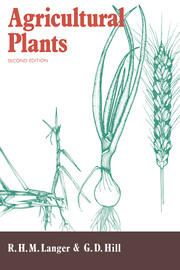Book contents
- Frontmatter
- Contents
- Preface to the first edition
- Preface to the second edition
- 1 World population and crop production
- 2 Plant structure
- 3 Liliaceae
- 4 Poaceae
- 5 Apiaceae
- 6 Asteraceae
- 7 Brassicaceae
- 8 Cannabinaceae
- 9 Chenopodiaceae
- 10 Cucurbitaceae
- 11 Fabaceae
- 12 Lamiaceae
- 13 Linaceae
- 14 Malvaceae
- 15 Papaveraceae
- 16 Solanaceae
- 17 Physiological basis of yield
- Index of specific names
- Subject index
5 - Apiaceae
Published online by Cambridge University Press: 05 June 2012
- Frontmatter
- Contents
- Preface to the first edition
- Preface to the second edition
- 1 World population and crop production
- 2 Plant structure
- 3 Liliaceae
- 4 Poaceae
- 5 Apiaceae
- 6 Asteraceae
- 7 Brassicaceae
- 8 Cannabinaceae
- 9 Chenopodiaceae
- 10 Cucurbitaceae
- 11 Fabaceae
- 12 Lamiaceae
- 13 Linaceae
- 14 Malvaceae
- 15 Papaveraceae
- 16 Solanaceae
- 17 Physiological basis of yield
- Index of specific names
- Subject index
Summary
This family is also sometimes known as the Umbelliferae after the distinctive umbel which its members bear at flowering. It comprises 275 genera with over 2800 species which are mainly confined to northern temperate regions but are sometimes found at high altitudes in the tropics. Besides three major vegetables – the carrot, celery and the parsnip – members of the family are utilised as herbs such as parsley and chervil or the seeds are used as spices such as aniseed, caraway, coriander, cumin and dill. The family also has classical connections, as the three kings who visited the infant Christ carried with them as a gift the perfume myrrh which is derived from Myrrhis odorata. On a less pleasant note, the Greek philosopher Socrates was executed by being given an infusion of hemlock (Conium maculatum), a species which is still a common weed in many temperate countries.
Members of the family are mostly biennial or perennial herbs. The stems are seldom woody but may be quite stout and are often hollow. The leaves are alternate and the petioles may be expanded or sheathing at the base. The leaves are compound and in most species are highly divided. As the former name of the family suggests, the inflorescence is an umbel (Fig. 5.2) which may be simple or compound, and in some species it may be subtended by bracts which form a whorl under the main or the branch umbel.
- Type
- Chapter
- Information
- Agricultural Plants , pp. 146 - 153Publisher: Cambridge University PressPrint publication year: 1991

